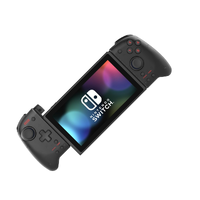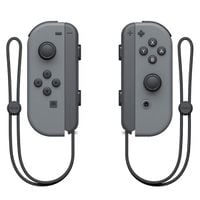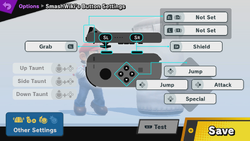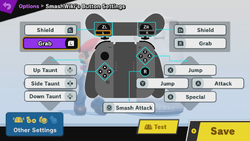| Welcome to SmashWiki! Log in or create an account and join the community, and don't forget to read this first! |
| Notices |
|---|
| The Skill parameter has been removed from Smasher infoboxes, and in its place are the new "Best historical ranking" and "Best tournament result" parameters. SmashWiki needs help adding these new parameters to Smasher infoboxes, refer to the guidelines here for what should be included in these new parameters. |
| When adding results to Smasher pages, include each tournament's entrant number in addition to the player's placement, and use the {{Trn}} template with the matching game specified. Please also fix old results on Smasher pages that do not abide to this standard. Refer to our Smasher article guidelines to see how results tables should be formatted. |
| Check out our project page for ongoing projects that SmashWiki needs help with. |
Joy-Con
The Joy-Con is a controller for use with the Nintendo Switch console. Like the Wii U GamePad, the Joy-Con have near field communication functionality, specifically the right Joy-Con, allowing the use of amiibo with games. Additionally, the Joy-Con are equipped with "HD Rumble", a more advanced form of haptic feedback to replicate the feel of in-game activities.
The Joy-Con are unique in that they can be used as controllers regardless of whether or not they are physically connected to the Nintendo Switch. They can be connected to the Nintendo Switch itself when in handheld mode, forming something similar to the Wii U GamePad. With the exception of the handheld-only Switch Lite, they can also be disconnected from the standard or OLED model Switch in handheld or docked mode, functioning as wireless motion controllers; they can also be optionally be placed in the Joy-Con grip, emulating the feel of a game controller. The left and right Joy-Con function as a pair in all of the aforementioned modes, but one can also use a single Joy-Con as a controller by holding it sideways.
The Joy-Con cameo in-game via the Robot Kit Mii Costume, referencing their usage in the Nintendo Labo games.
Compatibility
Joy-Con are currently only compatible with the Nintendo Switch with currently no confirmation on if they will be made forwards compatible with future consoles. That being said, their bluetooth connectivity allows them to connect to other devices and unofficialy be used as controllers for compatible games, though additional drivers may need to be installed for a smooth experience.
In Ultimate, the buttons on the Joy-Con can be remapped in the Controls menu to perform other functions in both singular and dual format. As of Nintendo Switch hardware version 10.0.0, every button on the Joy-Con can be remapped via the system's settings, further diversifying its customizability.
Standard controls in Super Smash Bros. Ultimate
Single Joy-Con (Left)
Note: From the perspective of the Joy-Con on its side
| Move | |
| Standard attacks | |
| Special moves | |
| Jump | |
| Grab | |
| Shield | |
| Taunt | |
| Pause | |
| Screenshot | |
| Nothing |
Single Joy-Con (Right)
Note: From the perspective of the Joy-Con on its side
| Move | |
| Standard attacks | |
| Special moves | |
| Jump | |
| Grab | |
| Shield | |
| Taunt | |
| Pause | |
| Home Menu | |
| Nothing |
Dual Joy-Con
| L |
Move |
| Standard attacks | |
| Special moves | |
| R |
Stick-smash |
| Jump | |
| Grab | |
| Shield | |
| Taunt | |
| Pause | |
| Home Menu | |
| Screenshot | |
| Nothing |
Technical data
Input lag
Each of the Joy-Con have similar latency to the Switch Pro Controller, experiencing lows of 93.7ms (5.6 frames) and highs of 112.86ms (6.8 frames). On average, however, it reaches around 103.33ms (6.3 frames), which is overall better than what the Switch Pro Controller can offer. However, its button size, potential for joystick drift due to wear, and restrictions on being used together in 8-Player Smash (because each Joy-Con registers as one controller even when docked, while a Switch can only support eight controllers at a time) makes its competitive viability questionable.
Near field communication
Within the Control stick of the right Joy-Con is a special chip that can send and receive data from other compatible chips from a distance of up to 4 centimeters. With relevance to the Smash series, this includes all compatible amiibo figures and their corresponding features within the game.
Licensed Variants
Hori D-Pad Joy-Con
Released in 2018 by Hori. Ergonomically identical to the standard Joy-Con, except the directional buttons are replaced with a Directional pad, mimicking the Switch Lite model.
Hori Split Pad Pro

The Hori Split Pad Pro is an alternative to standard Joy-Con, released in 2018. These Joy-Con have a completely different design, being larger and more ergonomic, resulting in an appearance close to a Nintendo Switch Pro Controller. Like the licensed D-Pad Joy-Con, the Split Pad Pro features a standard Directional pad; it additionally features two additional, freely-mappable buttons on the back of the controller handles, more conventional Start and Select buttons, as well as turbo and "assign" buttons. However, they are handheld mode-only, have no NFC for amiibo use, and no rumble, gyroscope, or infrared communication.
While incompatible with the usual Joy-Con attachment set to function as a normal controller, a custom version is available, thereby making the Split Pad Pro function as a standard Pro Controller; it also comes with a headphone jack.
In competitive play
The single Joy-Con is generally considered the worst official control scheme for Ultimate. Its small size and layout designed to be ergonomic when held upright with one hand makes it unintuitive to be held on its side with both hands, especially for people with large hands. The shoulder buttons, unused when held upright, are also difficult to press without an add-on that doubles as a wrist strap.
Joy-Con used as a pair have a much more positive reception. They include just as many buttons as other options, meaning every Smash input can be used without context sensitivity like controls in previous games. The ability to be used in tandem without a connecting wire like the Wii Remote and Nunchuk means the player can be in whatever position they want while playing, leading to a much more comfortable experience. While their small size is still an issue for some, these complaints are less prevalent due to the Joy-Con being designed to be held in this fashion.
Gallery
Trivia
- The single Joy-Con is the only controller layout where clicking on the control stick serves a function; in this case, activating taunt in conjuntion with a directional button.
- Despite this, stick clicking cannot be configured as a button press on the Controls menu in Ultimate.
- The left Joy-Con by itself is also the only controller layout where the Minus button has a function in Ultimate, where it functions as Start.
- In Training Mode with a single Joy-Con, clicking the analog stick activates the Move List and doing so on the character selection screen will cycle palette swaps to the right (same as pressing the SR button).
| hide Controllers and buttons | |
|---|---|
| Nintendo 64 controller | |
| GameCube controller | |
| Wii Remote (and Nunchuk) | |
| Classic Controller | L |
| Nintendo 3DS | |
| Wii U GamePad / Pro Controller | L |
| Joy-Con | |
| Switch Pro Controller | L |
| Third-party controllers | Hori Mini Pad · Arcade controller · Keyboard |
| Other | Smash Controller · Controller modification |







